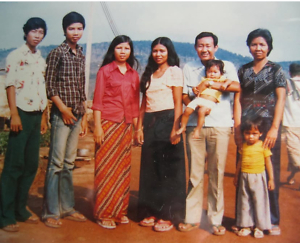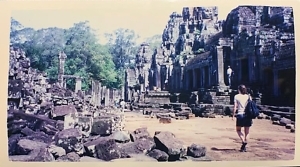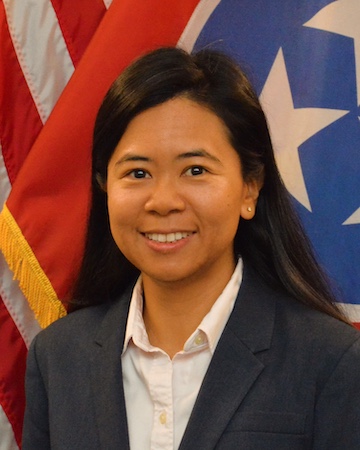A Healing Journey
I’ve come to see that a person can be molded from the soil of many places
My name is Botum and I’m Cambodian.
On April 17, 1975, Khmer Rouge soldiers captured Phnom Penh, the capital city of war-torn Cambodia, and began transforming the country into a vast and lethal forced-labor camp. By the time their reign of terror ended in 1979, an estimated one in four Cambodians was dead. My parents made it to the Khao-I-Dang refugee camp in Thailand, and I was born there in 1980. A year later, my father, pregnant mother, and I immigrated to the United States.

We eventually settled in Santa Ana, California, in a roach-infested apartment building populated with Cambodian refugees building new lives. My mother set up her own personal sweatshop — a commercial-grade sewing machine in a converted walk-in closet — while my father, who’d been a doctor in Cambodia, studied for a U.S. medical license. My brothers and I learned to help our mother with her work and proudly wore the handmade clothes she made us from scraps. Eventually, after 15 years and a detour as an acupuncturist, my father (“Ba” in Khmer) passed the boards and obtained the necessary certification that allowed him to practice medicine. He worked seven days a week caring for the families of Cambodia Town.
Our American life wasn’t easy, but we felt very lucky to be here.
Still, the killing fields followed us. I don’t remember my parents ever sitting me down to tell me about “Pol Pot Time” (what Cambodians call the Khmer Rouge era), but it was always there, darkening everything — a silent shadow of fear and grief.
The 1984 film, The Killing Fields, filled in some of the horrific details for me. I will never forget gaping at our staticky TV screen, a stunned five-year-old, as the actor playing Dith Pran slipped a lizard into his pocket to eat later. I turned to my mother and asked whether she’d had to eat lizards during Pol Pot Time.
“That’s nothing,” she said. “We had to do worse.” She did not elaborate.
I was stunned. I couldn’t imagine anything more terrifying than what I had just seen. Later, when I was older, my mother told me she’d once sprinkled tangy boiled ants over a watery gruel to transform it into a makeshift sour soup. This was how those rare revelations came: nothing for years, and then a bomb would drop.
Ba was even more tight-lipped. One of the few things I remember him saying about that time was that he’d been afraid to tell the Khmer Rouge he was a doctor, because they were known to murder professional and educated people, so he pretended to be a duck keeper instead. He was able to pass because he grew up poor in the countryside.
During Pol Pot Time, my father survived by lying. Afterward, he survived by staying silent.
Despite the taboo, I wanted to know the place. By 2000, during my sophomore year at Bryn Mawr, that craving had built into a powerful momentum, pushing me toward home. I’d just taken my U.S. citizenship oath and applied for a passport, and I felt Cambodia was finally safe enough to visit. U.N. peacekeepers were stationed throughout the country, Pol Pot had died two years earlier, and the last Khmer Rouge holdouts had officially surrendered in 1999.
My best friend Victoria and I planned a trip for summer of 2000, and to my immense surprise, Ba agreed to be our chaperone. It was to be his first trip back since he and his sister made it out of the killing fields, the only 2 survivors of 10 siblings.
As the plane descended toward Phnom Penh airport, the cabin erupted into cheers — it seemed that most of the passengers were, like me, Khmericans visiting Cambodia for the first time. My heart surged with joy, and I turned to look at Ba. There were tears in his eyes. I had never seen him cry before, and I didn’t know how to react. Feeling awkward, I turned to look out the window.
From far above, the country was just as I imagined: rice fields, sugar palms, and tiny villages to the horizon. At that time, Cambodia was still under the tourist radar, so this felt like our last chance to see the real Cambodia. But what was the “real” version of this beautiful, proud, devastated place? Landmine-pocked countryside or tranquil rice fields? The majestic ruins of Angkor or the modern capitol?
Phnom Penh was everything at once, swirling and buzzing: untreated human waste floated like crude oil on the surface of the capitol’s three rivers. The streets were packed with cars, motorbikes, bicycles, cyclos, and tuk-tuks at all hours. Except on a few main boulevards, there were no traffic lights or lanes, and yet it all seemed to flow organically.
The outdoor central market had a frenetic swap-meet feel to it. Vendors sold fish of all shapes and sizes; some would occasionally flop out of their containers and wriggle across the pathways. The huge baskets filled to the rim with fried crickets absolutely amazed me. But the incredible array of edible creatures for sale didn’t shock me nearly as much as the small boys I saw wandering the market, begging for money.
I had so many questions: Where were their parents? Where did they sleep? And why didn’t they have the expected number of limbs? I had never seen such mangled and starved human beings. The vendors treated them like a public nuisance and shooed them away.
My heart ached for those boys as they followed us through the market. The faster we walked, the more urgently their prosthetic legs clanked after us. Ba and an uncle, our guide that day, warned me not to give them money.
At a fruit stall, Ba bought me a dark green, conical lotus pod. Since the name Botum means “lotus blossom” in Khmer, he thought I should taste the lotus seeds. I popped the peanut M&M-sized seeds out of the pod and gave one to Veronica. We peeled the soft, bright green skin to get to the edible, ivory seed. It tasted slightly sweet and had a nice crunch with a creamy texture. We had finished about half the seeds and were glowing with the thrill of trying something new. My father looked pleased.
We stopped by the stands selling sarongs, and an emaciated little boy, about 6 or 7, came up to me and politely asked for the lotus pod. We’d eaten all we wanted, so I absentmindedly handed it to him.
The moment the pod touched his hand, the other boys dove onto him in a frenzy. It looked like a scene from Lord of the Flies. My uncle ushered us to his car at a run.
The mood turned grim. No one said anything. I wanted to apologize, but I didn’t know to whom. My shame about this bad American tourist moment and the old schoolyard mockery of my name stirred together and left me sickened.
But the lowest moment of the trip was yet to come. An “auntie” — actually, a cousin of Ba’s — hosted a dinner at a fancy restaurant with the guest of honor being her eldest brother, who was visiting from the countryside. I noticed there was a hushed undertone whenever the adults spoke about him amongst themselves. I was all ears but didn’t want to seem too nosy. I wondered why he lived so far away from everyone. Wasn’t he the patriarch of the family? Eventually, my auntie offhandedly mentioned that he was a Khmer Rouge. Things made more sense after that. He lived in the countryside because he was shunned. Apparently, everyone knew this except me.
Before dinner that night, I had a full-blown fit in the room I shared with Victoria. Until that moment, I lived my entire life thinking the Khmer Rouge were strangers. But the truth was, some of them were our own family and friends. Victoria was not surprised. She was a better student than I, and she read books before our trip that discussed this fact.
At dinner that night I was expecting to find a monster, but instead I found a meek and quiet man. The story he told us was that he was involved in “transportation” and nothing more during Pol Pot Time. There it was: the banality of evil, sitting right in front of me in the form of an ordinary-looking Cambodian grandpa. I felt gutted and stayed quiet for the rest of the night.

There were lighthearted and glorious moments, too, amid the dark ones. Like the time I scandalized my auntie by projectile vomiting onto a sacred mountain after an ill-advised bite of pig’s intestine. I was so sick that I had to be carried up the rest of the mountain by two young men in a hammock. I remember floating blissfully in the turquoise Gulf of Thailand and the way Victoria and I shocked my auntie with our American swimwear. She modestly wore a sarong in the water. The water was so warm and the entire beach was empty, except for us. On a perfect day in Siem Reap, Victoria and I scrambled to the top of Angkor Wat, and I felt I could see the whole world from up there. When vertigo froze me, she shouted, “You’re on a sacred temple your ancestors built. You’re not gonna fall!”
Truth: I didn’t fall, but I did stumble a few times on that trip. I had expected Cambodia to feel like home from the moment I arrived. Sometimes it did, like the unexpected joy I felt when I rode a bike in circles around my uncle’s driveway as the sun set one evening. In those moments, I felt comfortable and forgot about the barbed wire around the perimeter of the property. Other times, I was overwhelmed by unfamiliar soups, smells, and mores. I couldn’t ignore the starved amputee boys or the murderer who blithely sat down to dinner, as if all this were completely normal. I suppose those sensations meant I was at least as American as I was Cambodian.
In the years since, I’ve come to see that a person can be molded from the soil of many places, not just one or the other. And I now know that a place — like a family — can stir many things in us: belonging and strangeness, pride and shame, nostalgia and longing.
I’ve broadened my notions of what home means. After almost four years in Nashville, this city has become one of “my” places. It feels familiar in strange ways. A few months after moving here, I realized that my neighborhood was built on a Civil War battlefield. A friend from California asked me if I was scared. No, I’m Cambodian. In my other homeland, thousands of unmarked mass graves lie fallow by the edges of villages all over the country. It’s odd to say out loud, but I’m reminded daily that every family has its secrets and every culture its buried bones and hidden shame.
Cambodia is almost halfway across the Earth from Nashville, but no matter where I am, history is ever present in my life. I hope that trip, and the few words and stories that have spilled out of my parents over the years, have helped them toward some kind of peace. I will forever be grateful to Ba for taking me and Victoria on our Cambodia adventure. The trip ended long ago, but I’m still learning from it to this day. In fact, since that awful day in the market, I’ve thought a lot about my name: the lotus, a Buddhist symbol of purity and enlightenment. I’ve finally come to see “Botum” as a gift to me, a daily reminder of the lotus as metaphor: Like us Khmers, it can be cultivated in a murky irrigation canal or a cesspool and still bloom beautifully — and it can provide sustenance out of nearly nothing.
Despite my name, I cannot lay claim to purity or enlightenment. I’ve learned that enlightenment isn’t a place, but a path. It’s a constant movement toward greater mindfulness and a sustained effort to do more good than harm in the world. I am proud to have a name that embodies that journey of healing and transcendence.
My name is Botum, and I was born in a refugee camp. I live in Nashville, Tennessee. I’m Cambodian. And I’m also American.
Copyright (c) 2025 by Botum Chhay. All rights reserved.

Botum Chhay is an attorney and writer based in Nashville, Tennessee. She is a Bryn Mawr grad who loves traveling, playing tennis, and discussing philosophy.

